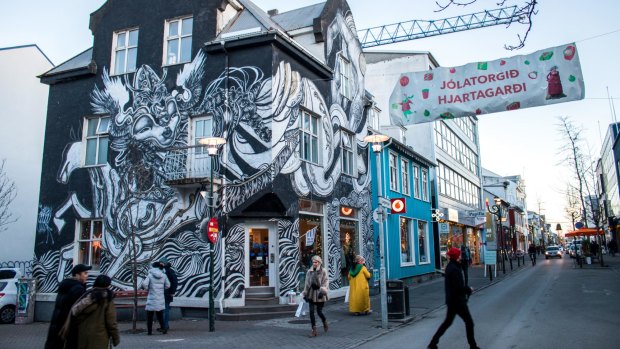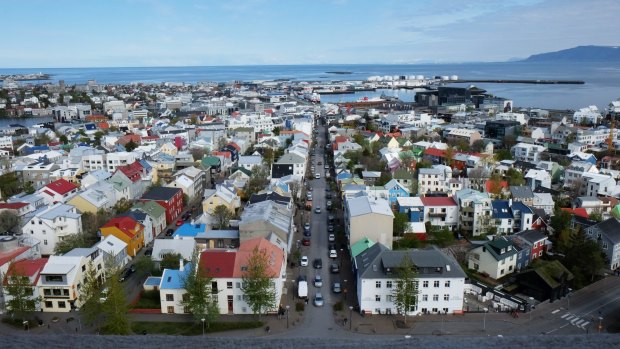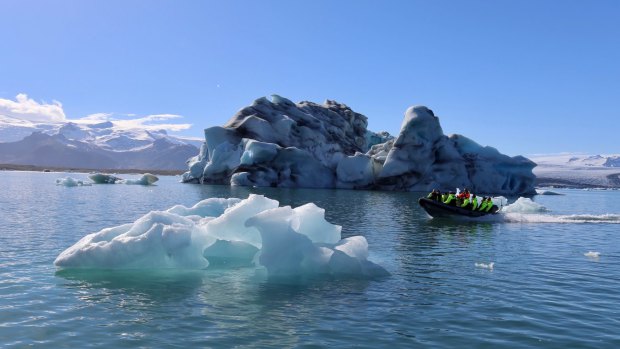This was published 6 years ago
Iceland: One of the most amazing and popular travel destinations on Earth
By Daniel Scott

Reykjavic.
"The tribal leaders have spoken," I imagine Haddur Gustavson, undersecretary in Iceland's Ministry of Waterfalls, declaring at the Viking Parliament, at Pingvellir, in about 1051.
"They have decreed that we must make another foss, near the broad tongued glacier," continues Gustavson in my mind, as we travel through the country's south-east, near the mid-point of our 10-day Intrepid Iceland Discovery tour.
"But Haddur," protests Eigur Erikson, the man charged with implementing the "waterfalls for all" policy, "the island is already full of fosses. There's Gullfoss near here, mighty Dettifoss in the east… "

Reykjavic.
"Oh, Eigur, you know the people love waterfalls," interrupts Gustavson, "they can drink from them, bury treasure under them and have a nice pickled herring picnic beside them. Anyhow, the southern tribesmen will murder us all if they don't get what they want."
"OK, OK, but can't we do something a bit different, this time? Like make it narrow and on several levels and have it twist and turn," suggests Erikson, hopefully. "Like rapids in a river, only with bigger drops?"
"Oh, you crazy creative types, never happy with a good old long drop," smiles Gustavson. "Go on, then."

Icebergs on the Jokulsarlon glacier lagoon.
It's almost 1000 years since that fictional meeting but travelling around Iceland, in an Intrepid tour group including 10 Aussies, two Americans and a forthright young Icelandic guide, Stefan, the regularity of our stops at waterfalls convinces me that they must have been methodically planned.
As we journey anti-clockwise from the capital Reykjavik, we pause, walk and picnic beside many a spectacular foss.
First there is Gullfoss, part of the "Golden Circle" of attractions close to Reykjavik that also includes the former Viking parliament, founded in 930, and the Strokkur geyzer, spouting broiling volcanic discharge 30 metres into the air.
Triple-stepped and bellowing and crashing at 4900 cubic metres a second into a 35-metre deep canyon, Gullfoss was built to make humans feel insignificant.
Then comes Seljalandsfoss, on the south coast. Crashing down 65 metres from the old sea cliffs, it forms a convulsing curtain that we walk behind, albeit at the cost of getting soaked. And there's Skogafoss, with its 60-metre drop and 25-metre width, forming rainbows with its spray and, according to legend, protecting a chest full of Viking gold anchored in the pool beneath.
Finally, for artistic merit it's hard to beat Svartifoss, at Skaftafell, in Vatnajokull National Park. Fed by glacial melt, it bursts and tumbles down 12 metres, between fluted black basalt columns that appear like organ pipes ranged symmetrically in a natural cathedral.
This is my second visit to Iceland. The first, in 2014, established it as my favourite country.
On that road trip, mostly spent in the less-known Westfjords and in North Iceland, it was the combustive and ever-changing backdrop combined with the warmth and humour of the Icelandic people that won my heart.
For me, Iceland's only drawbacks are that it is, in places, infested by tourists, and that it is super expensive. Icelanders remain welcoming but, in the capital Reykjavik, we do witness locals advising tourists to "go home". We're later shocked when a soup and bread lunch at a regional museum costs the equivalent of $27.
Happily, this Intrepid tour takes us away from the hoards, as early as day three, as we head to the south coast. It also represents a relatively affordable way of seeing Iceland, with accommodation in mid-range guesthouses and some meals and most activities included.
Apart from the cacophony of cascades, which lend the countryside vitality and movement, the landscape we travel through is shaped by ferocious eruptive energy and by gargantuan glaciers sliding down mountainous slopes and across volcanic craters.
A mere 25 million years old, Iceland is one of the planet's youngest land masses, and feels like a work in progress.
"Other-planetary" best describes vistas like the lava fields, filled by moss-coloured boulders, formed by the eruption of the Lakagigar volcano in 1783-84, that we cross on day four.
That cataclysmic event produced a 14-square-kilometre lava tsunami that destroyed 20 villages and killed 50 per cent of the nation's cattle, leading to a devastating famine. Its repercussions were felt across the world, with 120 million tonnes of sulphur dioxide spewed into the atmosphere, causing crop failures and an acrid haze in Europe and beyond.
Elsewhere, we pass by Iceland's tallest mountain, Mount Hvannadalshnokur, rising from a volcano rim and presiding over a glacier, five kilometres in diameter, that fills its crater with ice.
Further on we stop at Svinafellsjokull, a tongue of the massive Vatnajokull ice cap. A formidable bastion of lava-discoloured ice and bergs, it was used as the location of "beyond the wall", the frozen home of the Wildlings in Game of Thrones.
Yet, on a sunny afternoon, there is surely no sight more compelling, in a nation full of extraordinary settings, than the Jokulsarlon glacier lagoon, on the south coast. Taking an amphibious boat tour here, we see house-sized ice floes chiselled and excoriated by wind and water, and shot through with colour from luminescent turquoise to basalt black. It looks like the work of another Icelandic ministry. As do the crystalline icebergs that adorn nearby Diamond Beach, appearing like honeycombed art installations melting on the fine, black sand.
After curling around the east fiords, deep and sparkling, we reach the Highlands, on a drizzly afternoon. When we stop briefly, I'm drawn to a mossy bank and lie down upon it, allowing the energetic hum of the Icelandic ground to reverberate through me.
In the late 1960s, NASA used this vast volcanic plain, as close to a lunar landscape as they could find on earth, to prepare astronauts for landing on the moon.
It seems a lifeless wasteland. Yet, perhaps because of its isolation, stories persist of a Loch Ness-like monster inhabiting Lake Lagarfljot up here. Indeed, as recently as 2014, the local council's "truth commission" authenticated a video, shot by farmer Hjortur Kjerulf, showing the huge worm-like creature sidling through the ice.
That night, over an excellent reindeer steak at our Highlands farmstay, we debate its existence, before moving on, next morning, to Europe's most powerful waterfall, Dettifoss, which marks the midway point of our journey around Iceland.
In a country full of raging falls, this unstoppable 100 metre-wide, 45 metre-drop torrent, causes the hairs on my neck to rise as, with no safety barriers, I get to within touching distance of its thunderous, frothing lip.
Whether it was that visionary Viking ministry or other powers that created it, it's staggering, unguarded sites like this that help vindicate all the foss around Iceland.
Daniel Scott travelled as a guest of Intrepid.
TRIP NOTES
MORE
FLY
British Airways flies from Sydney and Melbourne to Keflavik (near Reykjavik) via Singapore and London. See britishairways.com
TOUR
Intrepid Travel's Iceland Discovery tour starts and ends in Reykjavik and takes travellers to see glaciers, geysers, geothermal hot springs and waterfalls. The trip includes visits to Thingevellir (Pingvellir) National Park, Strokkur Geysir and Gullfoss Waterfall. The 10-day trip costs from $4380 a person twin share, including accommodation, transport, some meals and most activities. See intrepidtravel.com
Sign up for the Traveller Deals newsletter
Get exclusive travel deals delivered straight to your inbox. Sign up now.